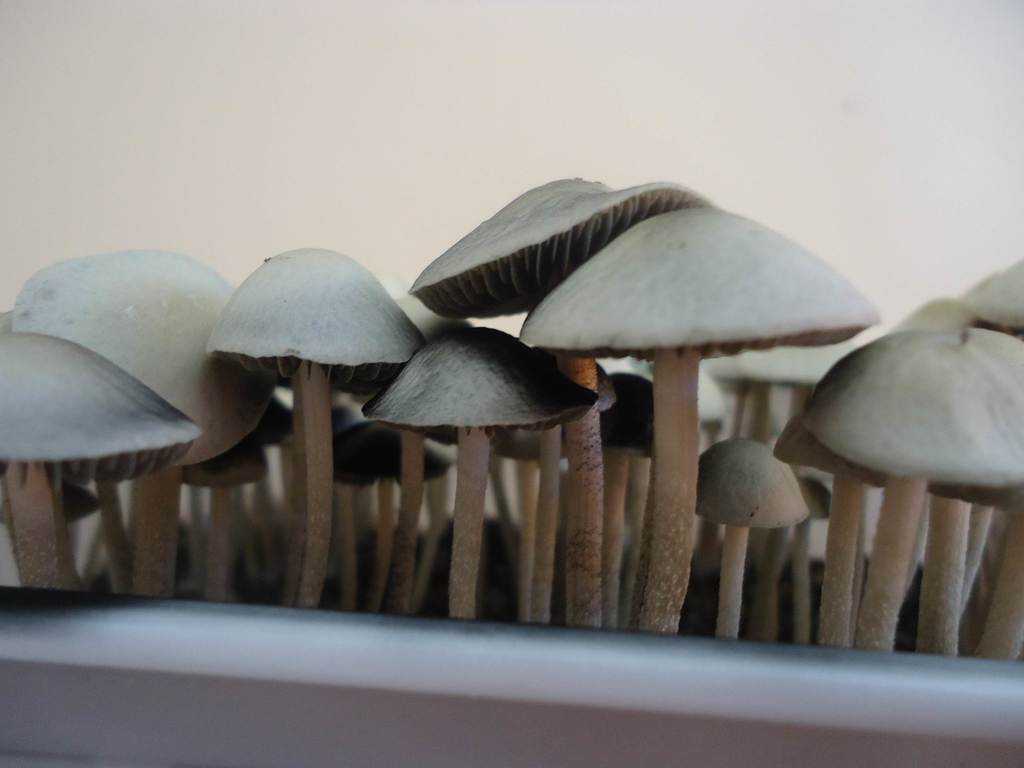Panaeolus cambodginiensis[i][ii] is a psychoactive mushroom originally discovered in Cambodia, though its range actually extends across much of southern Asia and even to Hawaii. The species can be cultivated, and there are some cultivated strains with their own colorful names, almost like the famous Psilocybe cubensis. However, P. cambodginiensis is so similar to several other species that it can’t be differentiated without a microscope and it’s not entirely clear that P. cambodginiensis is a full species and not a subspecies of something else.
Identification & Description
Cap: Small, initially conical in shape but opening with age to nearly flat and somewhat irregular. May crack. Red-brown when very young, becoming reddish-yellow or tan with maturity. Bruises blue if handled. The interior flesh is yellow but turns blue when cut.
Gills: Pale at first, becoming dark gray to black with maturity. The spores mature in irregular patches so that the gills are mottled for a while. The gills are attached to the stem, but only narrowly.
Stalk: Proportionately long and thin, whitish or cream-colored, blues quickly if handled. There is a ring zone—not a ring—visible near the top.
Spores: Lemon-shaped.
Spore Print: Black
Edibility: Psychoactive, but not otherwise considered toxic.
Habitat: Eats manure, preferably of buffalo or cattle, or soil enriched by manure. Lives in warm, subtropical climates.
Range: Not precisely known, but probably through much of the Asian subtropics and in Hawaii.
P. cambodginiensis can only be differentiated from Panaeolus cyanescens (commonly known as blue meanies) with the help of a microscope. In fact, the two are similar in potency and similar in cultivation, and some people suspect they are actually the same species[iii].
Look-Alikes
P. cambodginiensis and P. cyanescens are extremely similar, as noted, but most other Panaeolus species are somewhat similar-looking. Also, P. cambodginiensis definitely counts as a “little brown mushroom,” or LBM, meaning there are a great many species to which it bears a superficial resemblance that can confuse someone who isn’t thorough about mushroom identification—key out all the details, and there shouldn’t be a problem. Grab a mushroom because it “looks right” and there can very much be a problem, since some LBM are dangerously poisonous.
Benefits
The benefits of P. cambodginiensis are essentially those of psilocybin. Like other psilocybin-containing species, these mushrooms can be used recreationally, spiritually, and therapeutically. Whether psilocybin can do all the things claimed of it is a little unclear, as research has so far been extremely preliminary (it is difficult to conduct research on the use of a substance whose use is mostly illegal), but the list of things users say it has helped them with is very long: anxiety, depression, epilepsy, chronic pain, obsessive-compulsive disorder, addictions, severe headaches, and personal growth.
Toxicity, Safety, and/or Side Effects
P. cambodginiensis is not generally considered toxic aside from containing psilocybin, but it’s important to recognize that psilocybin is a toxin, it’s just one whose effects many people enjoy. Should someone get dosed with psilocybin who wasn’t expecting it, though, the results could be quite serious. Anyone who eats a psilocybin mushroom by accident, including children or pets, should be treated for mushroom poisoning by a competent doctor.
Taken intentionally, psilocybin can still have side effects, some of them serious. The most common side effects are merely unpleasant, such as nausea. More serious side effects, such as debilitating anxiety and problems with balance and coordination, are rare but become more likely at higher doses, especially at unexpectedly high doses. Convulsions and even death are possible but extremely rare. It’s important for psilocybin users to follow some basic safety procedures, such as erring on the side of taking too little rather than taking too much and never tripping alone. Also, the whole power of psilocybin is its ability to change the way the mind works—proper preparation and careful integration of the experience afterwards are critical for psilocybin use to be constructive and positive rather than, shall we say, questionable.
P. cambodginiensis specifically is highly potent, meaning that accidental overdose is easy—even if you know how much you should take, an error in measurement could easily have you taking too much. And, as with all other psychoactive mushrooms, potency can vary, making calculating the correct dose difficult. Avoiding over-dose is still entire possible, it’s just a little trickier than it might be with a less-potent species.
Then, too, please remember that psilocybin in any form, even the form of a mushroom, is illegal to use or possess in most jurisdictions, and penalties can be severe. Engaging in black-market purchases not only risks prosecution but also risks acquiring a poor-quality, contaminated, or even miss-identified product—after all, you can’t complain to the authorities when the authorities don’t want you making the purchase in the first place. So know the law in your area, avoid questionable sources, and stay safe.
References:
[i] (n.d.). Panaeolus cambodginiensis. Shroomery
[ii] (n.d.). Panaeolus cambodginiensis. Wikipedia
[iii] Cannabolic (2016). Panaeolus cambodginiensis vs. Panaeolus cyanescens. Shroomery



